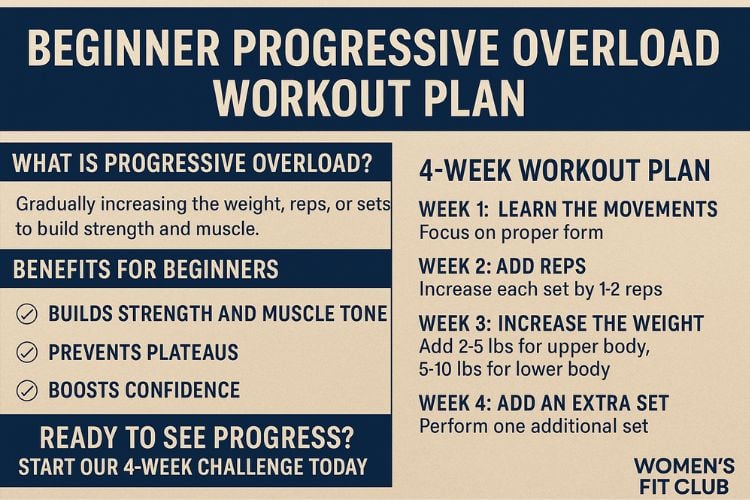Sign up for workout ideas, training advice, reviews of the latest gear and more.






If you’ve been working out regularly but feel stuck at the same strength level, you’re not alone. Many fitness beginners reach a plateau because their bodies adapt to the same level of effort over time. The solution? A proven, science-based training approach called progressive overload. This beginner-friendly progressive overload workout plan is designed to help you build strength, tone muscles, and see visible progress week after week—without overtraining or confusion. You’ll learn exactly what progressive overload is, why it works, and how to apply it safely using simple, effective exercises.
Progressive overload is the gradual increase of stress placed on the body during exercise. It’s the foundation of every successful strength and muscle-building program. When you continuously challenge your muscles—by lifting slightly heavier, doing more reps, or improving form—you stimulate adaptation.
Over time, your muscles become stronger, your endurance improves, and your body composition changes. Without progressive overload, your body simply maintains its current level of fitness.
Your muscles respond to stress by repairing and growing stronger after each workout. If the stress (load) stays the same, your muscles have no reason to adapt. By gradually increasing the challenge—just a little each week—you create a cycle of stress, recovery, and growth.
Progressive overload isn’t just for advanced lifters—it’s the best way for beginners to build a foundation of strength safely. Here’s why it’s so effective:
By steadily increasing your resistance or workload, you recruit more muscle fibers, which leads to stronger, more toned muscles.
If you’ve been doing the same workouts without seeing changes, adding progressive overload ensures your body continues to adapt.
Tracking small weekly improvements gives you motivation and measurable proof of your progress.
As your muscle mass increases, your metabolism naturally speeds up, helping you burn more calories—even at rest.
Progressive overload can be achieved in multiple ways, depending on your fitness goals and available equipment. You don’t need to add huge amounts of weight each week; the key is small, consistent progress.
The most direct form of overload—adding small increments of resistance (1–5 lbs for upper body, 5–10 lbs for lower body).
If you’re not ready to increase weight, perform one or two extra repetitions per set.
Gradually increasing total volume (for example, from 3 sets to 4 sets) can challenge muscles differently.
Perfecting your range of motion and tempo increases the intensity without changing the load.
Shortening your rest between sets can boost cardiovascular demand and overall training density.
Before starting this workout plan, keep these beginner-friendly guidelines in mind:

This 4-week program combines full-body strength training with gradual progression each week. You’ll train 3–4 days per week, alternating between upper and lower body days, plus one full-body session.
The focus here is on proper form and learning your baseline weights. Perform each workout 3 days per week (e.g., Monday, Wednesday, Friday).
Alternate between A and B for three total sessions.
Once you feel comfortable with all exercises, add 1–2 reps per set while maintaining the same weight.
Example: If you did 3 × 10 last week, do 3 × 11–12 this week.
Keep your form strict, and record your new numbers.
Now that your muscles are adapting, it’s time to slightly increase the load. Add 2–5 lbs to upper-body lifts and 5–10 lbs to lower-body lifts.
Maintain the same reps as in Week 2, focusing on control. If form breaks down, lower the weight until you can perform each rep cleanly.
To end your first cycle, keep your Week 3 weight and rep range, but add one additional set for each exercise (e.g., 3 sets → 4 sets).
This added volume pushes your muscles further, ensuring continued adaptation.
After Week 4, take 2–3 days of rest, then start a new cycle with your Week 4 weights as the new baseline.
| Day | Focus | Workout |
|---|---|---|
| Monday | Upper Body | Workout A |
| Tuesday | Rest or light cardio | |
| Wednesday | Lower Body | Workout B |
| Thursday | Rest or active recovery | |
| Friday | Full Body | Combine A + B with lighter weights |
| Saturday | Optional cardio or mobility | |
| Sunday | Rest |
This workout keeps you moving while reinforcing full-body strength and stability.
The biggest secret to success in a progressive overload plan is tracking.
Here’s how to stay accountable and consistent:
Write down the date, exercise, sets, reps, and weights. Note how each session felt.
Compare numbers week-to-week to ensure steady improvement.
Even a 5 lb increase or an extra rep counts as progress.
Even with the best intentions, beginners often make a few errors that slow progress. Avoid these to keep improving safely:
Adding too much weight too soon can lead to poor form and injury. Stick to small, consistent increments.
Always warm up with 5–10 minutes of light cardio and dynamic stretches before lifting.
Overtraining leads to fatigue and plateaus. Rest days are crucial for recovery and muscle growth.
Muscles need protein and balanced nutrition to repair and grow. Focus on lean proteins, complex carbs, and healthy fats.
Without tracking, you won’t know when to increase your weights or reps.
Your body gets stronger after your workouts, not during them. Proper recovery is just as important as training itself.
You don’t need a gym to apply progressive overload. Here’s how to do it at home with minimal equipment:
You can apply the same method to push-ups, lunges, or glute bridges—simply increase reps, sets, or difficulty over time.
Training is only half the equation—nutrition fuels your progress.
Aim for 0.8–1 gram of protein per pound of body weight daily to support muscle repair.
Whole grains, vegetables, and fruits provide steady energy for workouts.
Avocados, nuts, and olive oil help hormone balance and recovery.
Dehydration can cause fatigue and reduce strength performance. Aim for at least 8 cups of water daily.
After your first 4-week cycle, reassess your progress. Ask yourself:
If yes, start a new cycle with slightly higher weights. You can also introduce new exercises to challenge your body in different ways.
The beauty of a beginner progressive overload workout plan is that it rewards consistency over perfection. You don’t need to push to extremes—just aim to improve a little bit each week.
Remember, progress isn’t always linear. Some days you’ll lift more; other days, you’ll focus on form and control. What matters most is showing up and trusting the process.
Ready to take your training to the next level?
Start your Women’s Fit Club Progressive Overload Challenge today and see how far you can go in just four weeks. Track your lifts, celebrate your wins, and build lasting strength—one rep at a time.
Want more workout and video guide?
Follow us on Pinterest, Facebook, and Subscribe to our Newsletter and Stay tuned for FREE downloads of our App coming soon!
Stay up to date on the latest women’s health, fitness and lifestyle trends and tips.